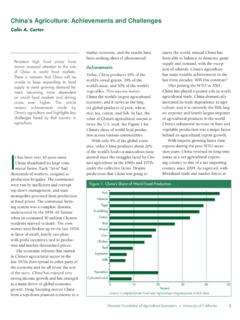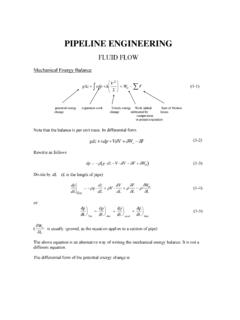Transcription of A History of California Agriculture
1 A History of California Agriculture Alan L. Olmstead and Paul W. Rhode December 2017 UNIVERSITY OF California Agriculture AND NATURAL RESOURCES THE AUTHORS Alan L. Olmstead is professor emeritus in the Department of Economics at University of California , Davis. Paul W. Rhode is professor and chair in the Department of Economics at University of Michigan. Contact: Alan Olmstead, GIANNINI FOUNDATION The Giannini Foundation of Agricultural Economics was founded in 1930 from a grant made by the Bancitaly Corporation to the University of California in tribute to its organizer and past president, Amadeo Peter Giannini of San Francisco.
2 The broad mission of the foundation is to promote and support research and outreach activities in agricultural economics and rural development relevant to California . In line with those goals, the foundation encourages research in various areas of interest to agricultural and resource economists and supports dissemination of research fndings to other researchers and to the public. Foundation membership includes agricultural economists (faculty and Cooperative Extension specialists) at the Department of Agricultural and Resource Economics, Davis, and at the Department of Agricultural and Resource Economics, Berkeley.
3 Associate members include forestry economists in the College of Natural Resources, Berkeley, and economists in the Department of Environmental Sciences at Riverside. This and other Giannini Foundation publications are available in PDF format online at Julie McNamara Managing Editor and Communications Director Giannini Foundation of Agricultural Economics Contact: 2017 by the Regents of the University of California Division of Natural Resources All rights reserved. No part of this publication may be reproduced, stored in a retrieval system, or transmitted, in any form or by any means, electronic, mechanical, photocopying, recording, or otherwise, without the written permission of the publisher and the authors.
4 To simplify information, trade names of products have been used. No endorsement of named or illustrated products is intended, nor is criticism implied of similar products that are not mentioned or illustrated. A History of California Agriculture A History of California Agriculture Alan L. Olmstead and Paul W. Rhode In recent years, California has accounted for over one-tenth of the value of the agricultural output. Perhaps more impressive than the value of farm output is the great diversity of crops, the capital intensity, the high yields, and the special nature of the state s agricultural institutions.
5 California 's agri-culture evolved differently from what was found in the home states and countries of the immigrants who settled and farmed its soils. These differences were not just an outcome of the state s distinct geoclimatic features; they were molded by the farmers, laborers, researchers, railroad barons, and policy-makers who interacted to create one of the most productive and dynamic agricultural-industrial complexes in the world. Two contrasting legends dominate the telling of California s agricultural History .
6 The frst extols California farmers as progressive, highly educated, early adopters of modern tech-nologies, and unusually well organized to use irrigation to make a desert bloom. Through cooperation, they prospered as their high-quality products captured markets around the globe . This farmers-do-no-wrong legend is the mainstay of the state s powerful marketing cooperatives, government agencies, and agricultural research establishment, and largely ignores agricultural workers. The second and darker legend sees the California agricultural system as founded by land-grabbers whose descendants continue to exploit migrant workers and abuse the Golden State s natural environment.
7 Even in its mildest form, this view faults California farmers for becoming full-fedged capitalists rather than opting for a more environmentally and labor-friendly system of family farms as in the Midwest. The contest between these compet-ing interpretations of California s farm system has raged for the past one-and-a-half centuries, with each side seldom even talking to the other. Neither legend has engaged in a system-atic and objective analysis of the available data nor offered the comparative perspective needed to assess why California Agriculture developed as it did.
8 This chapter analyzes major developments in California s agri-cultural History to provide a better understanding of how and why the state s current agricultural structure and institutions emerged. We focus on major structural transformations: the rise and fall of the extensive grain-growing economy of the nineteenth century; the shift to intensive orchard, vine, and row crops; and the emergence of modern livestock operations. Intertwined with our discussion of sectional shifts will be an analysis of some of the special institutional and structural fea-tures of California s agricultural development, including farm power and mechanization, irrigation, and the labor market.
9 In these areas, California s farmers responded aggressively to their particular economic and environmental constraints to create unique institutional settings. The results have been remarkable, albeit with signifcant environmental problems and continuing labor unrest. 1 Giannini Foundation Information Series 017-1 The Grain Empire Bonanza Farms Early settlers found an ideal environment for raising wheat: great expanses of fertile soil and fat terrain combined with rainy winters and hot, dry summers.
10 By the mid-1850s, the state s wheat output exceeded local consumption, and Cali-fornia s grain operations began to evolve quite differently from the family farms of the American North. The image is vast tracts of grain grown on huge bonanza ranches in a coun-tryside virtually uninhabited except at harvest and plowing times. California grain farms were very large for the day and used labor-saving and scale-intensive technologies, pioneering the adoption of labor-saving gang plows, large headers, and combines.











